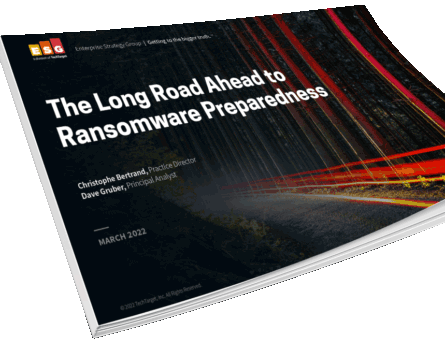What is ransomware recovery?
Ransomware recovery is the ability of an organization to regain access quickly and flexibly to any and all of its data that cyberattackers have encrypted and stolen for financial gain. In the best-case scenario, organizations recover from ransomware attacks confidently and at scale without downtime or data loss. An effective ransomware recovery plan is increasingly a sign of a cyber resilient organization, capable of continuously protecting valuable data and maintaining demanding business service-level agreements (SLAs).
Leading ransomware recovery services and solutions feature data management and data security capabilities that allow teams to rapidly restore many different data sources—virtual machines, large databases, and large volumes of unstructured data—to any point in time and location as well as use machine learning to ensure a full clean snapshot recovery.
Why is ransomware recovery important?
Ransomware recovery software and a recovery plan are important because bad actors are producing more malware for attacks on businesses faster than ever. That’s making it no longer a matter of if but when an organization will experience a breach or ransom event.
Leading security experts from Cybersecurity Ventures predict a ransomware attack on a business every two seconds by 2031. That’s significantly more often than analysts’ earlier prediction of every 11 seconds by the end of 2021.
Most organizations are unprepared for what’s coming. When respondents in an Enterprise Strategy Group (ESG) study were asked if their actual recovery times met their pre-established SLAs, 78% said they’re unable to “always” meet their objectives, and 33% said they “sometimes” or “rarely” meet these objectives.*
Effective ransomware recovery software is important so that organizations:
- Avoid data loss and downtime — Ransomware locks up valuable data that organizations need to derive new insights while keeping employees productive, customers happy, and operations functional.
- Maintain customer and employee trust and confidence — New compliance and industry rules increasingly require organizations to inform customers of intrusions, creating discomfort among consumers that their data has been exposed to malicious actors.
- Prevent financial disaster — Organizations without effective ransomware recovery operations are being forced to pay exorbitant ransoms to attackers.
- Achieve regulatory compliance — Governments worldwide are passing privacy laws that can result in severe financial penalties for organizations with compromised data.
- Maintain competitive advantage — Preventing cybercriminals from breaching systems and stealing data helps companies continue to keep their trade secrets and intellectual property secure.
*Source: ESG Master Survey Results, Real-world SLAs and Availability Requirements, August 2020
What is a ransomware recovery plan and does your company have one?
A ransomware recovery plan is a strategic guide or framework and set of operations that enable organizations to counter the various ways cybercriminals aim to disrupt their business operations. The most effective plans for ransomware recovery address the increasing blast of ransomware:
- Ransomware 1.0 — These variants typically only targeted and encrypted production data. Robust backup systems were enough to address this threat and not pay ransom until attackers got bolder.
- Ransomware 2.0 — These variants aggressively attack backup data sets housed on traditional servers and supported by legacy data management solutions. Once the backup is deemed unusable or destroyed, attackers request ransom.
- Ransomware 3.0 — This newest tactic involves not only encrypting data and systems, but also data exfiltration or stealing the data, with the intent to release it if the organization doesn’t pay a ransom.
An effective ransomware readiness plan includes five key actions that can help organizations counter ransomware:
- Protect backup data and system(s).
- Reduce the risk of unauthorized access.
- See and detect attacks to stop encroachment.
- Strengthen security posture with integrations and APIs.
- Ensure rapid recovery of data at scale.
If your company doesn’t have a ransomware recovery plan powered by a ransomware data recovery tool, it is at a significant business disadvantage.
Can ransomware data be recovered?
Yes. Organizations around the world that have invested in modern data management solutions that include ransomware attack recovery capability, are empowered to be able to refuse to pay a ransom and recover their data.
After being hit with ransomware, Sky Lakes Medical Center, for example, instantly cloned the last good backup of its NAS shares and served those files directly from its data management solution—recovering the service to users without the need to move any data.
How long does it take to recover from ransomware?
It takes for organizations to recover from a ransomware attack varies widely and largely depends on what systems and data have been compromised. For single ransomware recovery files or databases, restores can be near-instant with a modern data management solution. For larger compromises and breaches, organizations can expect hours or days of work. After being hit with ransomware, Sky Lakes Medical Center said its recovery solution saved the team hundreds of hours of work.
What is the solution to ransomware?
The best solution to ransomware is to adopt a modern data management platform that features advanced data protection, security, defense, and recovery capabilities. The most effective data management software includes immutable snapshots, write once/read many (WORM) technology, data encryption, modern data isolation, machine-learning to spot anomalies, and rapid recovery of data at scale.
What happens if you don’t pay ransomware?
Organizations unable to keep their data protected from ransomware or that fail to institute a rapid ransomware recovery process can experience a number of negative business outcomes, such as:
- Data loss and downtime
- Loss of customer and employee trust and confidence
- Financial disaster
- Regulatory fines for non-compliance
- Competitive disadvantage
How much is ransomware recovery per day?
The cost of ransomware recovery per day varies based on the size of the attack and the data compromised. Yet, all organizations negatively impacted by ransomware need to factor in not only the financial costs—which can include loss of revenue—but also the loss of employee productivity and brand reputations when considering whether or not to adopt ransomware recovery software.
A 2021 State of Ransomware study revealed the average total cost of recovery from a ransomware attack more than doubled in a year, increasing from $761,106 in 2020 to $1.85 million in 2021. Moreover, global ransomware damage costs are predicted to exceed $265 billion by 2031, according to Cybersecurity Ventures.
Can companies recover from ransomware attacks?
Companies of all sizes and across industries can recover from attacks using ransomware data recovery tools while confidently refusing to pay the ransom. Their secret to ransomware recovery success is a modern data management platform with capabilities including immutable or unchangeable snapshots and data isolation.
How to create an effective disaster recovery plan?
The way to create an effective disaster recovery plan—focused on restoring IT systems as rapidly as possible from an unexpected event—is to start by outlining the following:
- The data and applications the business needs to protect above the rest
- The data to recover first if systems are compromised
- Service-level agreements (SLAs) define how soon users can expect key systems to be up and running
- Service-level objectives (SLOs) defined how much downtime of a critical app or system is acceptable to the organization or specific stakeholders
Once the disaster recovery plan is in place, teams can consider how to instrument it to best counter increasing ransomware attacks. The best ransomware recovery software—modern data management—is an ideal way to orchestrate a new or update an existing ransomware disaster recovery plan.
Are ransomware recovery programs effective?
Yes. A modern data management service is at the heart of an effective ransomware recovery program. It should include advanced data protection features such as immutable snapshots; robust data security including encryption and WORM; proactive data defense based on AI-driven insights; and data recovery capabilities that work rapidly and at scale.
How often ransomware recovery required?
Ransomware can attack at any time. That’s why every organization needs a comprehensive, proactive ransomware readiness plan and a solution that enables it to back up data and system(s), reduce the risk of unauthorized access, see and detect attacks to stop encroachment, strengthen security posture with integrations and APIs, and ensure rapid recovery of data at scale.
Cohesity and ransomware recovery
The Cohesity Data Cloud is one simple platform to secure and manage your data. If the worst-case scenario happens and ransomware attackers succeed, the Data Cloud empowers organizations to get back to business fast with critical data management recovery software capabilities such as:
- Instant recovery at scale — Cohesity’s platform allows teams to take advantage of immutable (or unchangeable) snapshots to rapidly restore hundreds of VMs, large databases or large volumes of unstructured data instantly, at scale, to any backup point in time and location.
- Clean recovery — The Cohesity solution helps organizations identify compromised snapshots. It includes a built-in machine-learning engine to recommend the last-known clean copy of data so organizations know when to perform the restore and that the snapshot data is free from anomalies and potential cybersecurity threats, accelerating recovery times and ensuring there’s no reinjection of potential malware back into the production environment.
- In-place recovery — Cohesity’s hybrid cloud ransomware recovery service (also available for software deployment on-prem) recovers data directly in place on the same platform without requiring organizations to spin up a new server or database, saving time and money.









